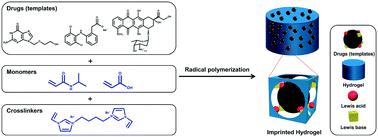当前位置:
X-MOL 学术
›
Mol. Syst. Des. Eng.
›
论文详情
Our official English website, www.x-mol.net, welcomes your
feedback! (Note: you will need to create a separate account there.)
Design of thermoresponsive hydrogels by controlling the chemistry and imprinting of drug molecules within the hydrogel for enhanced loading and smart delivery of drugs
Molecular Systems Design & Engineering ( IF 3.2 ) Pub Date : 2021-2-4 , DOI: 10.1039/d0me00097c Sang-Yu Park 1, 2, 3, 4, 5 , Seong Yeol Kim 2, 3, 4, 5 , Ji-Hye Kang 1, 2, 3, 4, 5 , Han-Sem Kim 1, 2, 3, 4, 5 , Ueon Sang Shin 1, 2, 3, 4, 5
Molecular Systems Design & Engineering ( IF 3.2 ) Pub Date : 2021-2-4 , DOI: 10.1039/d0me00097c Sang-Yu Park 1, 2, 3, 4, 5 , Seong Yeol Kim 2, 3, 4, 5 , Ji-Hye Kang 1, 2, 3, 4, 5 , Han-Sem Kim 1, 2, 3, 4, 5 , Ueon Sang Shin 1, 2, 3, 4, 5
Affiliation

|
Various drug delivery techniques have contributed significantly to medical practice. In particular, molecular imprinting is a suitable method to increase the drug-loading efficiency in limited 3D spaces, such as hydrogels. This method has recently been studied for the transdermal delivery of various therapeutic agents, but its full potential is yet to be achieved in molecular systems. In this study, thermoresponsive and molecularly imprinted hydrogels were prepared by radical polymerization with molecular imprinting using three types of drug molecules as templates. The drug templates—acyclovir (ACV), diclofenac (DFN), and doxorubicin (DXR)—were used to establish molecular correlations between molecularly imprinted hydrogels and drug molecules by using non-covalent Lewis acid–base interactions, hydrophilicity and molecular size. The DXR-imprinted hydrogel exhibited a much greater imprinting efficiency than ACV- and DFN-imprinted hydrogels because of the hydrophilic characteristics and large molecular size of DXR compared with the other drugs. The morphology, surface area, and swelling behavior, dependent on the temperature, were also investigated. The in vitro drug release studies performed at various temperatures revealed unique drug release profiles unlike previous thermoresponsive studies. This study demonstrated a facile strategy to construct molecularly imprinted hydrogels that exhibit thermoresponsive delivery and offer new guidelines to identify optimal combination between drugs and hydrogels.
中文翻译:

通过控制水凝胶中药物分子的化学性质和印迹来设计热敏性水凝胶,以增强药物的负载和智能递送
各种药物输送技术已为医学实践做出了重要贡献。特别地,分子印迹是在有限的3D空间(例如水凝胶)中增加药物装载效率的合适方法。最近已经研究了该方法用于各种治疗剂的透皮递送,但是在分子系统中尚未实现其全部潜力。在这项研究中,使用三种类型的药物分子作为模板,通过自由基聚合和分子印迹,制备了具有热敏性和分子印迹的水凝胶。使用非共价路易斯酸碱相互作用,亲水性和分子大小,使用了药物模板-阿昔洛韦(ACV),双氯芬酸(DFN)和阿霉素(DXR)-建立了分子印迹水凝胶与药物分子之间的分子相关性。DXR印迹水凝胶比ACV和DFN印迹水凝胶具有更高的印迹效率,这是因为DXR与其他药物相比具有亲水性和大分子大小。还研究了取决于温度的形态,表面积和溶胀行为。这在不同温度下进行的体外药物释放研究表明,与以前的热响应研究不同,其独特的药物释放曲线。这项研究证明了构建具有热响应性传递的分子印迹水凝胶的简便策略,并提供了确定药物和水凝胶之间最佳组合的新指南。
更新日期:2021-03-01
中文翻译:

通过控制水凝胶中药物分子的化学性质和印迹来设计热敏性水凝胶,以增强药物的负载和智能递送
各种药物输送技术已为医学实践做出了重要贡献。特别地,分子印迹是在有限的3D空间(例如水凝胶)中增加药物装载效率的合适方法。最近已经研究了该方法用于各种治疗剂的透皮递送,但是在分子系统中尚未实现其全部潜力。在这项研究中,使用三种类型的药物分子作为模板,通过自由基聚合和分子印迹,制备了具有热敏性和分子印迹的水凝胶。使用非共价路易斯酸碱相互作用,亲水性和分子大小,使用了药物模板-阿昔洛韦(ACV),双氯芬酸(DFN)和阿霉素(DXR)-建立了分子印迹水凝胶与药物分子之间的分子相关性。DXR印迹水凝胶比ACV和DFN印迹水凝胶具有更高的印迹效率,这是因为DXR与其他药物相比具有亲水性和大分子大小。还研究了取决于温度的形态,表面积和溶胀行为。这在不同温度下进行的体外药物释放研究表明,与以前的热响应研究不同,其独特的药物释放曲线。这项研究证明了构建具有热响应性传递的分子印迹水凝胶的简便策略,并提供了确定药物和水凝胶之间最佳组合的新指南。











































 京公网安备 11010802027423号
京公网安备 11010802027423号